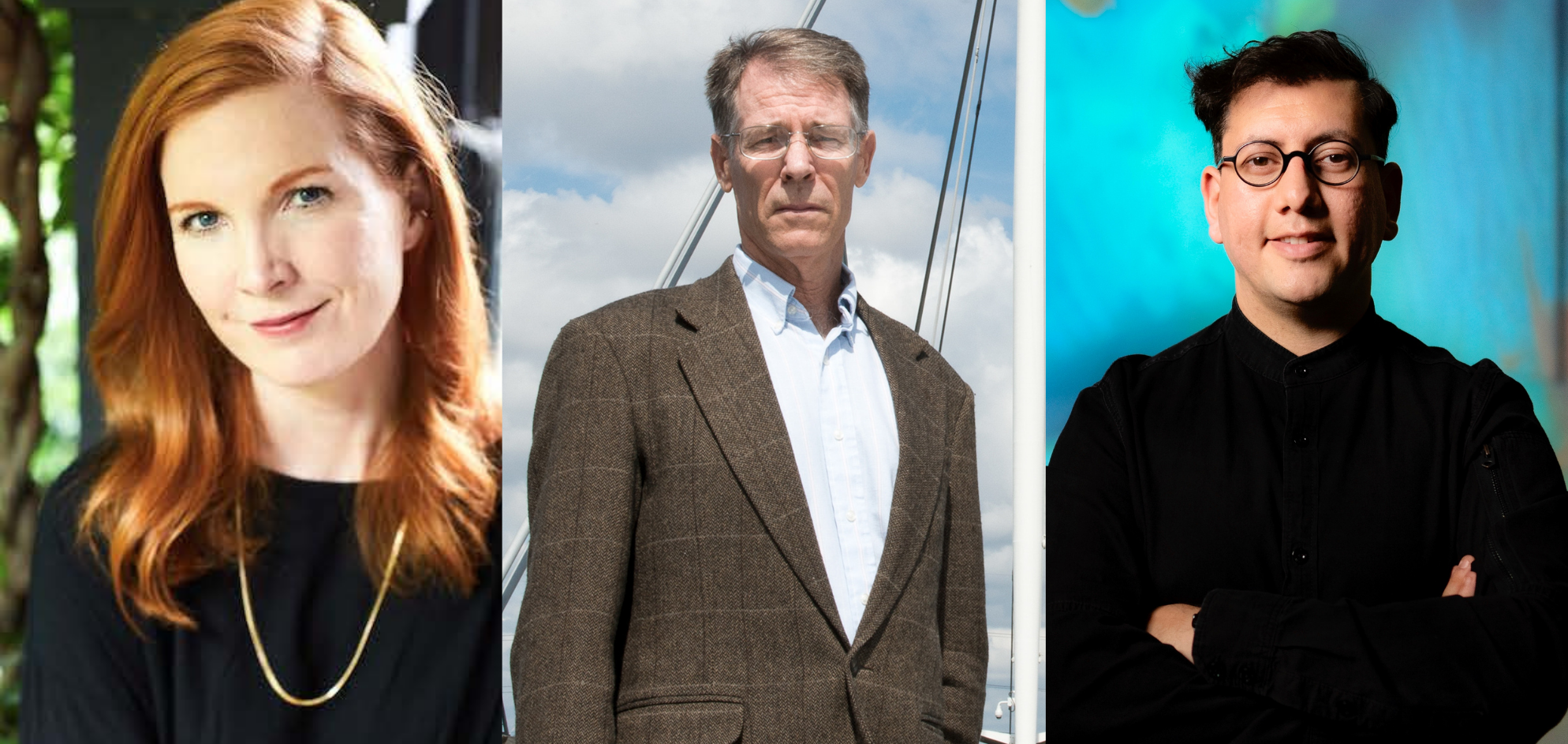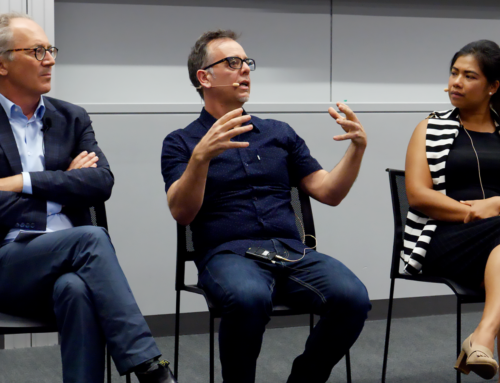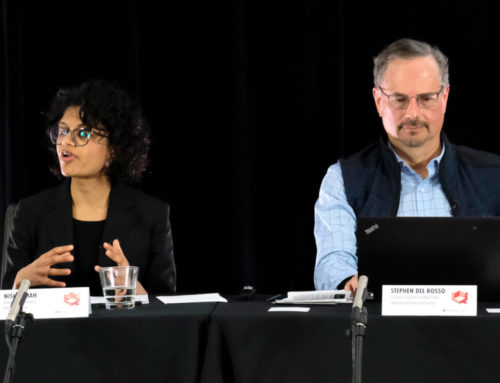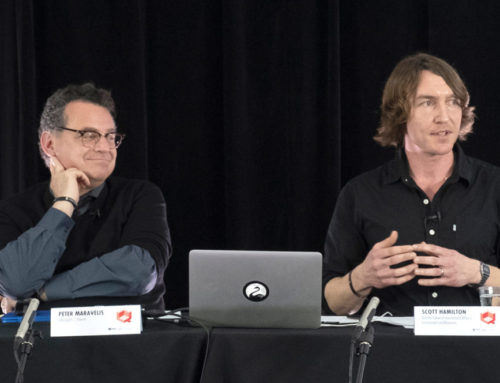Project Q panelists and presenters—Kate Crawford, Kim Stanley Robinson, and Refik Anadol
Last week’s news featured the innovative ideas and prescient perspectives of three headliners from Project Q’s Q6 Symposium. From uncovering the material reality of artificial intelligence, to imagining a future where our global economy is aligned with climate change imperatives, to opening the door to the next era of digital art—Kate Crawford, Kim Stanley Robinson, and Rafik Anadol shatter the boundaries between the arts, humanities, and sciences.
These headliners exemplify interdisciplinary thinking, communicating, imagining, and innovating. Their work challenges the borders that separate us, and encourages us to interrogate the current boundaries of our own thinking too.
Kate Crawford
‘A lot of people are sleepwalking into it’: the expert raising concerns over AI, Sydney Morning Herald
Last week, Kate Crawford was featured in a Sydney Morning Herald article speaking about the materiality of data and AI and exposing both the ecological and human costs of these technologies.
As Stephanie Wood from the Sydney Morning Herald takes a walk around Sydney’s CBD with Crawford, she points out the often unseen yet omnipresent signs of AI occupation along their route. On their journey, Crawford debunks the myth that these technologies exist for the convenience and good of the public. Instead, she explains, they have been created for private profit.
The results, she cautions, only serve to concentrate power into the hands of a very small, very localized, and very homogenous group. These omnipotent corporations are “widening asymmetries of power” in a dangerous way, and Crawford calls on us to take note.
This is the narrative that she eloquently weaves through her new book, ‘Atlas of AI’, which navigates “the myth of clean tech”, the omnipresence of AI tools and infrastructures, and the extractive nature of AI systems with great clarity and immediacy.
As the article highlights, Crawford shares information in a way that is intentionally approachable. Her work on AI and data crosses over the disciplines of art and science to make its way into public spaces like the permanent collections of New York’s Museum of Modern Art and London’s Victoria & Albert Museum.
Her work aims to make the invisible impacts of AI and data visible to all of us.
Watch Kate Crawford speak on our Looking Back Moving Forward panel.
Kim Stanley Robinson
A climate plan for a world in flames, Financial Times
While renowned science fiction writer Kim Stanley Robinson takes a futuristic perspective on the battle against climate change in his newest work, ‘The Ministry for the Future’, his recent op-ed for the Financial Times looks at what can be done in the here and now.
In the piece published last week, Kim Stanley Robinson speaks to the fragility of civilization, the power of science, and the need to redirect the priorities of our global financial system. The stakes couldn’t be higher. Ignoring that need, Kim Stanley Robinson writes, could result in nothing less than a mass extinction event.
Robinson points to a growing body of literature on carbon quantitative easing, which holds promise for realigning our global economic systems in a way that rewards and incentivizes efforts to decarbonize our world. Innovation and imagination will be key to re-writing the global financial narrative.
He argues that we must focus science and technology on the monumental task ahead of us: reverse the damage done. But in order to do so, we need more than just scientists and technologists in the room. As Stanley writes, “Aiming science is the work of the humanities and arts, politics and law.”
He leaves us with a simple question: “[Is it] easier to imagine the end of the world than the end of capitalism?”
Kim Stanley Robinson’s article suggests that the answer to this question doesn’t have to leave us wondering. It’s simple. In order to dodge a mass-extinction event, we must align our global political priorities, guide our technologies, and control our economy for the common good.
Watch Futuristics with Kim Stanley Robinson from our Q6 Symposium.
Refik Anadol
This NFT Painting Is a Work of Art: Machines are the new descendants of Picasso, Nautilus
Last week, Nautilus published an article exploring the world of digital art and imagining the future pathways that AI-produced art will take. Though the field of AI art is only just beginning to come into its own, artist Refik Anadol is one of the visionaries shaping its future with his machine learning-powered installations.
The article identifies Refik’s work, Archive Dreaming, as “a stunning example of the potential of machines to dream, to create a new world of extraordinary and beautiful images”.
To create Archive Dreaming, Anadol used 1.7 million documents from Turkey’s SALT Galata art institution’s online library and encoded them into numerical form. The project is an immersive experience where viewers are surrounded by the images projected onto the walls of a cylindrical room. When the installation is dormant, the machine learning algorithm kicks in, generating new data and producing images that look similar to the original data but that are in fact unique. The images of the documents created in Anadol’s installation have never existed, but it would be impossible for the viewers to distinguish between the real and AI-generated visuals.
The author of the article notes that what is fascinating about the work of Anadol and other digital artists who use AI as a medium, is that the resulting art allows us to understand how machines “think” and create.
Anadol’s work demonstrates how art and technology are fusing in the 21st century to create an oeuvre entirely unique to this world.
Check out Refik Anandol’s Quantum Memories project and discussion from Project Q’s Aesthetics panel.
You can access all the highlights from Project Q’s Q6 Symposium, Heuristics, Aesthetics, and Ethics, on our website here.







Leave a Reply